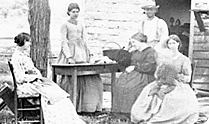Southern Women in the Civil War
Thursday, Oct. 7, 2010
7:00 p.m.–8:30 p.m. (EST)

Leader
Professor of History
Duke University
National Humanities Center Fellow
About the Seminar
When we think of southern women during the Civil War, we usually think of white women from slaveholding families who aligned themselves with the Confederacy. The problem with this image is that it conflates the South, which was a large and varied geographic region, with the Confederacy, which was a political movement that formed its own government and separated from the rest of the United States. Not all women who lived in the South were Confederates, and even those women who supported the Confederacy had differing levels of commitment to the cause. There were enslaved women who opposed the Confederacy from the start and saw the war as an opportunity to escape slavery; white women who remained loyal to the Union; and white women who came to oppose the war, even as they continued to support the Confederacy in theory.
This seminar will consider four categories of Southern women: the slaveholding elite, Unionist sympathizers, working class white women, and enslaved women. For each it will pose two overarching questions:
- How did they shape the conduct and outcome of the Civil War?
- How did the War affect them?
To address the first question, we will explore four themes: support, subversion, pressure, and protest. To address the second, we will discuss how the War changed the lot of all Southern women, casting some into deprivation and poverty and opening for others new possibilities in life.
Enter Moodle Forum
Assigned Readings
To incorporate seminar texts into your teaching, we offer the National Humanities Center’s Primary Document Application Form.- The Slaveholding Elite: Support
- Women seated in front of a house, near the battle of the second Bull Run (image)
- Unionist Women: Subversion
- Fugitive slaves fording the Rappahannock River, Virginia, 1862 (image)
- Refugees arriving in Union lines (image)
- Working Class White Women: Pressure and Protest
- “Sowing and reaping,” Frank Leslie’s Illustrated Newspaper, May 23, 1863 (image)
- Social Upheaval and New Possibilities
- Two women in black, walking by ruins, Richmond, Virginia (image)
- Freed family, five generations (image)
- Marriage certificate of black soldier and his wife, December 3, 1863 (image)
Presentation
PowerPoint: 258 KBOnline Evaluation
Seminar Recording
Download Recording (You will need to install the WebEx ARF player, available at download, to play back the recording.)
